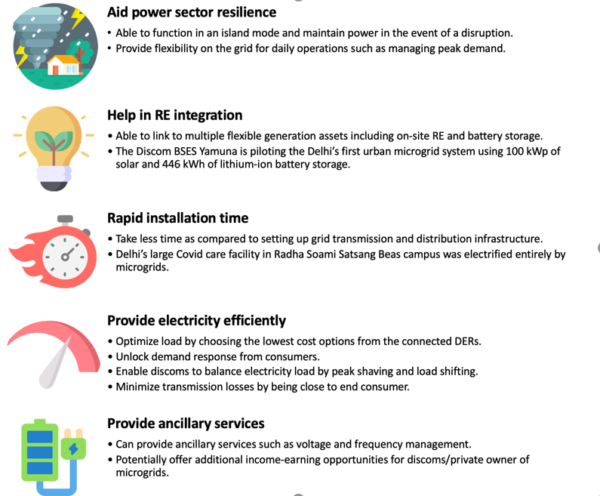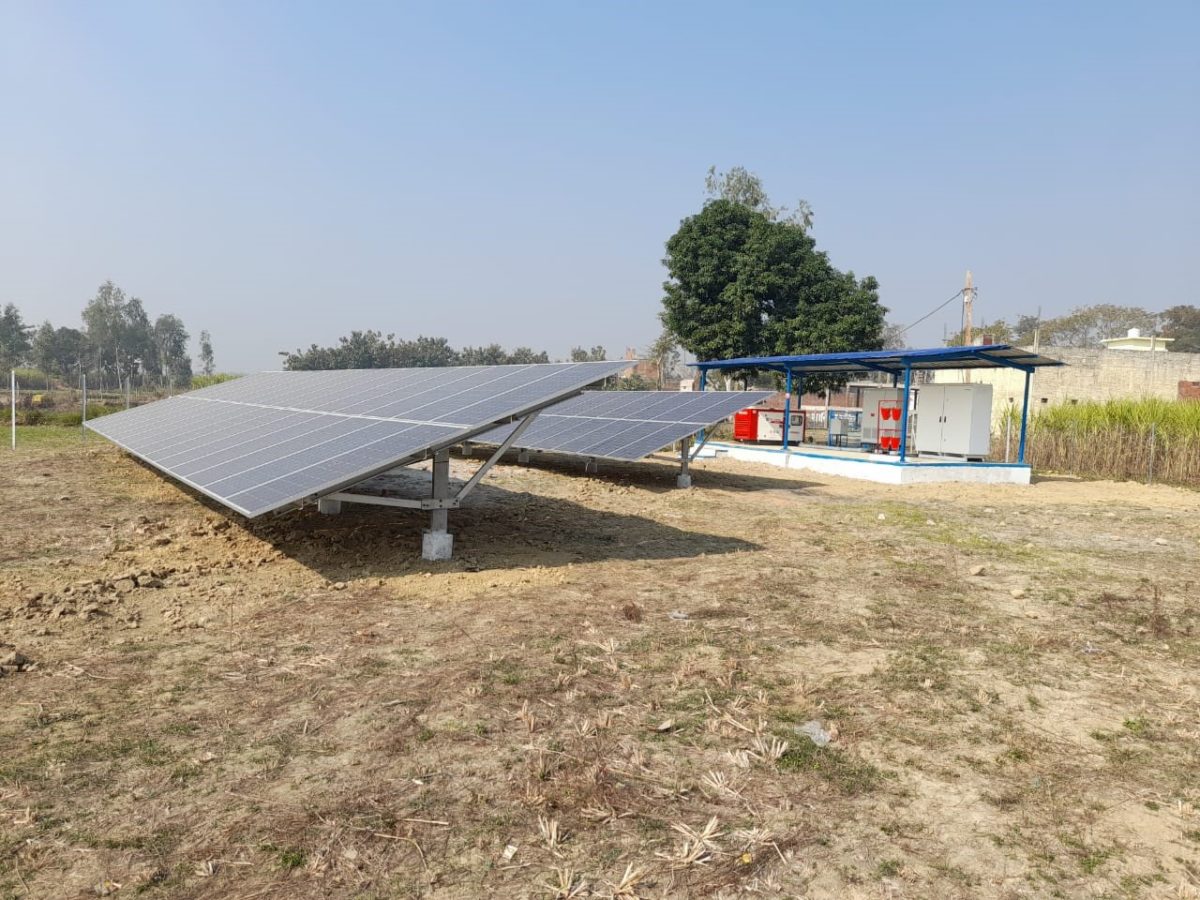Microgrids have traditionally been used in India to provide reliable access to remote off-grid rural communities. Urban areas, on the other hand, may not seem like likely candidates for microgrids as they tend to be well connected to the grid. However, urban areas can face routine power outages as well as impacts from extreme weather-related events and other externalities.
For instance, advanced electricity systems in countries like Singapore and Japan face less than five minutes a year of outages. In contrast, some Indian cities with the best grid service, like Mumbai and Delhi, can face annual outages ranging from under 20 minutes to under 20 hours respectively. This can go up to several days in a year in some other Indian cities.
These outages can be longer in cases where climate change induced extreme weather events ravage power systems, with electricity distribution being the most vulnerable part of the system. For instance, the infamous 2018 floods in Kerala and Cyclone Fani in 2019 that struck eastern India led to large scale destruction of electricity distribution infrastructure, leaving entire communities without access to electricity or telecom services.
Unreliable access to electricity can impose social and economic losses and increase vulnerabilities across different sections of society. Depending on diesel generators is not a great solution, as diesel is not only prone to disruption in supply itself, but it also compromises local air quality. Diesel-based electricity systems are also vulnerable to the cost of diesel, which has doubled over the past decade.
Therefore, microgrids can play an important part of a reliable urban electricity system. Microgrids with battery storage are distributed energy resources (DERs) that hold potential as an important infrastructure lever for bringing resilience benefits to the grid and playing a key role in envisioning the future of grid modernization.
The potential
Microgrids can make the electricity system nimbler and more robust in the face of disruptions. Their ability to function in “island mode” using sensors, controllers, and active management software ensures that power supply is maintained independent of the main grid even in event of disruptions. They also reduce reliance on transmission lines that are vulnerable to unmanaged vegetation and extreme weather. In addition, they provide flexibility to the grid during day-to-day operations. For example, microgrids that use on-site renewables such as rooftop solar can help relieve peak demand on the grid during afternoons, and later in the evenings through battery storage. This can help power distribution companies (discoms) avoid buying expensive power to meet peak demand.
These attributes help microgrids provide resiliency services to communities as well. As a region severely prone to destructive hurricanes, the Caribbean islands are a great example to showcase the vulnerability of power systems to extreme weather events, as well as the role that DERs can play in making that system more resilient and robust. After Hurricane Irma in 2017 devastated the electricity systems for many islands, the islands of Barbuda and Puerto Rico, among others, decided to rebuild their power systems by leveraging microgrids powered by renewables and batteries, as well as improved efficiency. Multiple microgrids that are interconnected can help tide over the risks that a centralized grid faces in extreme weather events.
Some additional ways in which microgrids complement the main grid are shown in the figure below.

The challenges
Urban microgrids may not face many of the challenges that microgrid developers in remote areas tend to face. These include high capital cost and the cost of wiring and setting up of meters combined with low household electricity consumption that may not be able to pay for it. The rapid penetration and growth in electricity consumption in urban areas, as well as their dense nature, hold the potential to drive down these concerns. That being said, microgrids can increase electricity costs initially and hence challenge the benefits of high-quality and reliable electricity in urban areas as well.
Secondly, microgrids are conventionally associated with a risk of stranded assets once the central power grid arrives. However, in urban areas, microgrids would emerge most likely alongside the existing grids, with the main value proposition being improved quality, flexibility, and therefore, resilience of supply. This calls for innovation in business models to support microgrid proliferation. Policy should take cognizance of either discoms owning the microgrids, or of microgrid owners being able to sell the asset or electricity to the discom and continue operations, similar to the provisions in some state minigrid policies like that of Bihar.
A change in the technological and logistical setup in the power supply system will require a changed support ecosystem as well. Operations and maintenance costs for microgrids may be high because of a lack of trained technicians. Another challenge to consider is whether urban microgrids are covered under central government policies.
The path forward
The government has taken introductory steps towards encouraging microgrids with the draft National Electricity Policy (NEP) 2021. NEP 2021 includes aspects that promote the use of minigrids powered by renewable energy and calls for enabling islanding of the system into microgrid and balancing electricity using storage, etc. The Central Electricity Regulatory Commission has drafted ancillary services market regulations that allow energy storage and demand response to participate in the market. This, along with draft NEP 2021’s call for distribution service aggregators, potentially makes DERs more viable, and consequently contributes positively to resilience building.
Another possibility that opens up with higher incidence of microgrids is that of creation of energy communities and scaling up peer to peer (P2P) trading, turning entire communities of consumers into prosumers. For example, some communities in countries like Australia, the UK, and the United States have been piloting blockchain microgrids that allow P2P trading at a neighbourhood level, creating a marketplace for transactions within virtual or physical microgrids. This is expected to unlock savings for consumers and improve grid resilience.
An interactive and decentralized microgrid that supports the larger power grid while integrating greater renewable energy has potential to make the sum greater than its individual parts. Transitioning towards this paradigm of flexibility, security, and resilience in the power grid will require upgrades in the policy and regulatory environment as well as business models for microgrids to attain scale. Yet this is critical work if we want to ensure reliable electricity for all.
Nuvodita Singh is an associate and Jagabanta Ningthoujam is a manager at RMI India
The views and opinions expressed in this article are the author’s own, and do not necessarily reflect those held by pv magazine.
This content is protected by copyright and may not be reused. If you want to cooperate with us and would like to reuse some of our content, please contact: editors@pv-magazine.com.








By submitting this form you agree to pv magazine using your data for the purposes of publishing your comment.
Your personal data will only be disclosed or otherwise transmitted to third parties for the purposes of spam filtering or if this is necessary for technical maintenance of the website. Any other transfer to third parties will not take place unless this is justified on the basis of applicable data protection regulations or if pv magazine is legally obliged to do so.
You may revoke this consent at any time with effect for the future, in which case your personal data will be deleted immediately. Otherwise, your data will be deleted if pv magazine has processed your request or the purpose of data storage is fulfilled.
Further information on data privacy can be found in our Data Protection Policy.